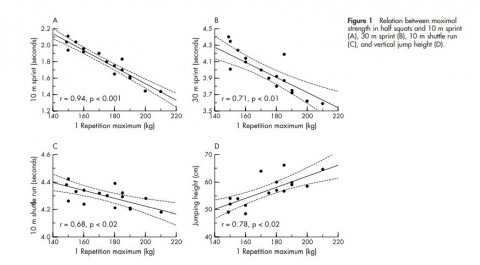Sprinting and vertical jump performance are important skills in the game of soccer. In terms of sprinting, a soccer player will sprint every 90 s during a match. These sprints average about 2-4 seconds and can account for up to 11% of the distance covered during a match. And with vertical jump performance think of all the times a player will go up for a header, off a corner or as a keeper exploding up to deflect a ball over the cross bar. So while intuitively it makes sense that sprinting and jumping are important in soccer it would be beneficial to know how important they are. And from a strength and conditioning perspective, how important is a strength exercise like the back squat, to improving these qualities? A group of researchers looked to answer these questions and called upon a Norwegian pro soccer club to participate in the study. 17 male soccer players from Rosenborg FC, average age 25 years, were put through a number of performance tests to see how what the relationship was between the 1 RM half squat with sprinting and jumping. Rosenborg FC is a top flight team in Norway having won their league a number of times and participating in the Champions League. For the 1 RM back half squat players did barbell back squats to 90 degrees of knee flexion, adding load until a 1 RM was determined. Once they were warmed up, most players took three to six sets to determine their 1 RM. For the sprint test, players ran from 0-30 m with photocell timing gates. Splits were recorded at each 10 m and the players rested 5 minutes between the two attempts. The best sprint time was included in the data presented. And for the vertical jump a force platform was...
